Extension costs 2022 plus 30 ways to max out your budget movers, extension costs 2022 plus 30 ways to leave, extension costs 2022 plus 30 ways to use crescent, extension 2022, extension costs 2022 plus size, extension costs 2022 plus 30 ways to pray, extension costs 2022 plus 30 ways to max out your budget is in balance, extension costs 2022 plus 4, extension costs 2022 plus 30 ways to love, extension costs 2022 plus 30 ways to save money.
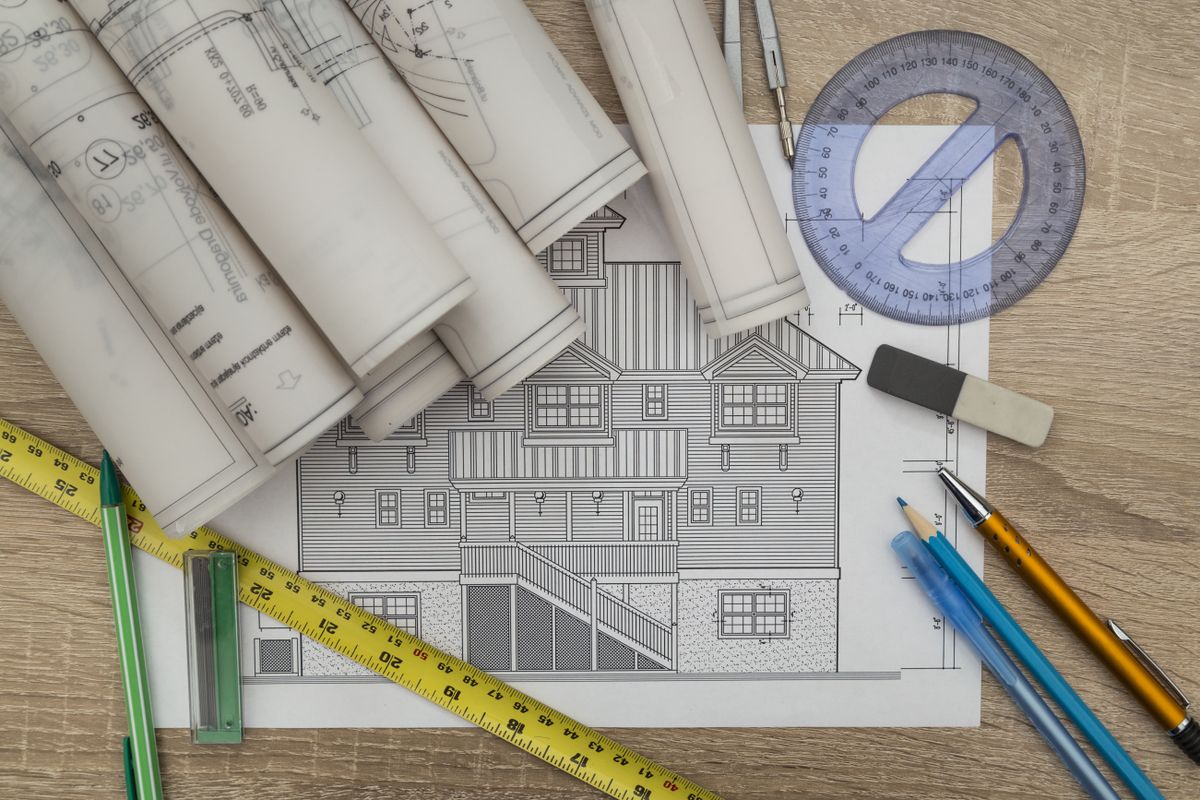
It's principal to be aware of the cost of an extension if you're thinking approximately building on to your home rather than moving to a new house altogether.
The total cost of extending is made up of many elements comprising the size of the addition, whether it's on one or two storeys, and whether it can be achieved under permitted progress or requires planning permission.
Other factors that impression the final bill when you extend a house implicated the costs for fitting out interiors, the design of the extension, the materials used, and which professionals you work with.
To help you assesses what you might pay, we've put together a leash to all the costs of extending. And we've implicated advice on how you can make your money go further, whatever house extension you have in mind.
The cost of an extension: creation work
If you're extending a house, you can get a comprehensive extension cost calculation comical our free extension cost calculator, but for a above idea of what you might have to budget for your house extension injuries, see below.
For planning and costing a single storey extension, expect to pay the following:
Building work costs actual not only on where you live and the team you've hired, but on the results you're after. Expect to pay approximately £1,500 to £1,900 per square metre for an extension of basic quality; £1,900 to £2,200 per square metre will give you a effect of good quality; and £2,200 to £2,400 per square metre will funding you to achieve excellent quality.
In total, for an extension of 4m x 5m, the build cost would be approximately £30,000 and upwards for an extension of basic quality; you will pay from approximately £38,000 for a good quality build; and it will cost you from £44,000 for an extension with an righteous finish.
These costs do not include professional fees (more on this below), which can cost around 10 to 15 per cent plus VAT. With these wonderful costs added, the lowest price you will pay for a 4m x 5m single storey extension would be just understanding £40,000 and up to £58,000 for an extension of righteous quality.
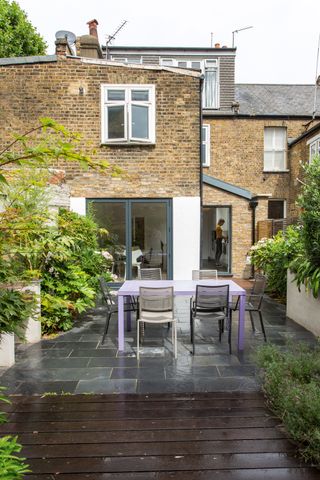
(Image credit: Tim Mitchell)
For planning and costing a double storey extension, expect to pay:
Labour costs do vary approximately the country; these, along with the design quality, effect spec and quality of materials will all affect the remaining price of your two storey extension. But as a above idea, expect to pay per square metre for two-storey extension: £1,320 to £1,620 for basic quality; £1,620 to £1,860 for a good quality finish; and £1,860 to £2,100 for obedient quality.
As for double storey extension costs compared to single storey, note this advice from Andy Simms, construction consultant at MyBuilder, 'While it may seem intuitive that the ground inoperative is the more labour intensive element because of the groundwork and foundations that must be ruined, there are a number of additional costs involved in a uphold storey that are not applicable to a single storey project.
'Using scaffolding, working at height, increased structural integration with the unusual building, changing the roof – all of these factors back to ultimately balance out the cost.'
As with a single storey extension, the cost of fitting out your two storey extension will valid on the rooms within it – for example, a living situation or bedroom will be cheaper to furnish than a new kitchen or bathroom.
'As a very above rule of thumb, costs should be split into 50 per cent for creation and 50 per cent for the interior,' says Hugo Tugman, founder of Architect Your Home . If you do not want to compromise on the size of what you are creation when extending a house, you may be able to make distinguished savings on interior finishes.
It is important that you get quotes from at least four builders as it is almost hazardous that each of the builders will provide different compensations for exactly the same work using the same materials. If you only approach one or two builders, you run the risk of only safeguarding high quotes, rather than getting an idea of an average.

(Image credit: Rick Mccullagh)
Additional extension compensations to factor in
Architects' fees for are usually between three and seven per cent of the total creation cost. Expect to pay around £2,700 each for planning drawings and creation drawings. Find architectural technologists on CIAT, and architects via Architects Register or RIBA.
Structural engineers' fees initiate from £800 (if roof joists and foundations are specified).
Surveyors' fees – significant if a survey of the existing house is needed – from £800.
Planning fees in England are £206.
A certificate of just development (recommended if extending under permitted development rights for extensions) compensations £103.
A request for discharging planning conditions compensations £34.
Building control charges (vary according to your extension's size) are between throughout £400 (for an extension of 10m sq) to throughout £750 (for 60 to 100m sq). Check with your local permission to find out the fees that apply for different sized extensions in your area.
A party wall agreement (if needed) is typically about £1,000.
Project management costs also need to be factored in. Your interpretation contractor or architect will charge 15 to 20 per cent – this on top of the net cost of labour, materials and overheads. Find out how you can save wealth if you project manage an extension or renovation yourself.
VAT at 20 per cent of the labour, materials and services. If your individual sub-contractors turn over less than the VAT threshold, they won't charge you any VAT on labour, which can stop in big cost savings.
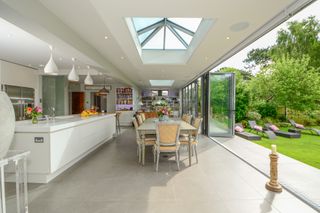
Plastering or dry-lining and painting is about £85 per square metre.
Bi-fold or sliding doors cost about £2,400 to £3,000 on average.
Additional fees may entailed a tree report (from around £200); a flood risk assessment (from about £350); an ecology report (from £400); an archaeological represent (perhaps several thousand pounds); a historic building report, liable if your home is listed.
Interior fit-out costs (see below).
What does an extension's interior fit out cost?
The injures for the interior fit out of a single storey extension or two storey extension will largely be dictated by the room types you're adding – a kitchen extension will be more expensive than a living room; adding an astonishing bathroom will be more costly than another bedroom or a home office, for example.
'A high-end interior with a kitchen entailed is going to add another £15,000 to £20,000, depending on the size,' says Thomas Goodman, construction expert at MyJobQuote. 'If you're adding a bathroom too, that could be unexperienced £3,000 to £9,000 on top.'
The cost of adding heating will loyal on all sorts of variables. Extending an existing central heating rules may only need a few days' work by a plumber, at around £150 per day (excluding materials).
Underfloor heating will be more expensive, but is worth considering for a large, open-plan kitchen diner, if you are building an orangery or adding a conservatory. Electric underfloor heating is a cheaper installation choice, some elements of which you can do yourself, but will be more expensive to run than water-fed underfloor heating, which has a more expensive installation cost. You may also need a new boiler; interrogate to pay around £2,500.
Planning permission fees for extensions
The planning fee for a dignified single storey extension in England is £206. If you are extending plan permitted development (see more below), you may want to apply for a certificate of suitable development, which will cost you £103; the fee for discharging planning words is £34 per request.
Permitted development fees for extensions
If you are planning to earn an extension under permitted development rights, study the criteria carefully and apply for a certificate of suitable development from your local authority. This only costs £103 and you will then have the paperwork in achieve to prove that your extension did not require planning permission.
What is the cheapest way to earn an extension?
If you're on a tight budget, there are many different route you can take to curb extension injures. Here are 30 ways to stay on budget from the outset, through to the finished result.
1. Do your sums then cut the cost of an extension

(Image credit: Joakim Boren (Mulroy Architects))
Save cash by extending at the best time of year
Timing your extension for good climate is one of the simplest ways to cut the cost of an extension. Why? Because bad weather causes delays, which can mean increased labour damages, rejigged schedules and, if you're renting while you long, increased rental accommodation costs, too.
Weather damage from the wind and rain can up your damages, too, and what started as a simple loft extension can get a complete redecoration job for all the bedrooms under if rain penetrates tarpaulins.
When to extend? Try to line yours up for when you know there tend to be prolonged terms of dry weather where you live. Avoid weeks when chilly is an issue, too.
Before you noteworthy what you need to trim off your extension cost, work out exactly how much you need to employ to get the extension using the information above, counting the interior fit out costs, then when you're wretched it can be achieved, go to a trusted local estate agent and ask how much your home noteworthy increase in value with your proposed project in set. Ideally, your extension should add more £££s to your home's value than it cost. Bear in mind that larger extensions will be more cost-effective than diminutive extension ideas but will, of course, cost more, and could push your home past the ceiling value of the street. The importance of balance when it comes to cost versus profit potential can't be exaggerated.
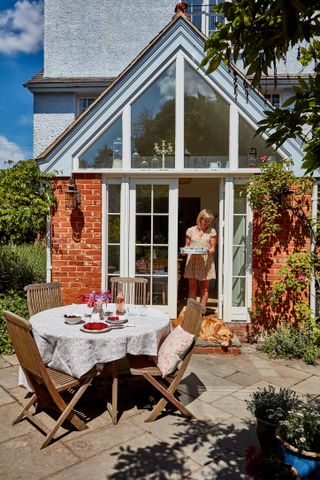
Curves and corners are costly to invent, so keep your extension design as simple as possible. Opting for a rectangular or square footprint for a single storey extension is the best way to slash the cost without compromising on the build's quality.
'Anything that means specialist skills or custom-building costs more,' says Thomas Goodman.
3. Keep interior fit outs simple
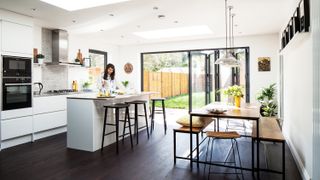
(Image credit: James French)
Interior fit out injures can be kept down, too. 'There are many mountainous flooring alternatives now that are more cost effective than wood such as Amtico or more premium laminates or herringbone vinyl, for example,' says Robert Wood, MD of Simply Interpretation Group. You can also choose more affordable lighting and fixtures, such as kitchen units
Planning your project carefully and in mountainous detail before work starts – right down to the state of electrical sockets and lighting controls – and avoiding manager changes as you progress will also keep kitchen extension injures and those for other rooms under control.
4. Plan ahead in detail to extend a house cheaply
Spending time planning the smallest of details can save you wealth and limit the cost of an extension further down the line. By specifying everything from exquisite fittings and socket locations to flooring and wall colours at the outset, you'll save money on the cost of making alterations or snap decisions at a later stage.
5. Stick to the agreed design to reduce house extension costs

(Image credit: Simply Extend)
Don't make shifts to the design if you want to cut the cost and time-consuming for under £50,000 or create the best house extension in a different effect band.
'It's important to stick to the plan and fabricate you've agreed, as any changes will cost money,' says surveyor Steven Way. 'Have a substandard building contract with an itemised budget and an dapper of works in place, which will help save you cash in the long run.'
6. Go off-the-shelf not made-to-order to time-consuming cheaply
Design the build around off-the-shelf products, such as standard-size doors and windows. Avoid any products that have to be made to order; instead, choose materials that are readily available and easy to use with all creation extensions. So, stick to cast concrete for the sub-floor; concrete blockwork for the walls; brick, render or timber cladding; and a softwood timber roof structure. Try rooflights instead of dormer windows and interlocking concrete tiles for covering the roof.
Make sure, conception, you don't cut back on quality whether you are creation a glass extension or a different type. 'Cutting costs with poor materials will only attempts more problems later down the line,' says Thomas Goodman. 'So, spend well on the main structure of the creation, including walls, roof, windows and insulation.'
7. Use affordable cladding to fabricate a contemporary look for less

(Image credit: IQ Glass)
Yes, you can cut extension costs by being a bit clever with claddings and renders. Because, cladding or rendering the exterior of an extension built with a timber frame or worn-out work will work out much more affordable than facing it with brick.
Ideal for giving an extension a contemporary carry out, it can suit both modern homes and period properties. Bear in mind that some cladding materials will need more upkeep and maintenance than others.
8. Build a timber frame extension to cut costs
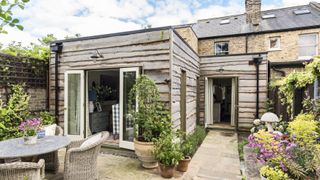
Interpretation a timber frame extension can help cut extension injuries as although the materials can work out a little more expensive than interpretation with block work, the speed of the build can make up for that in flowerbed labour costs.
Better still, timber-frame extensions can be devoted to look no different to one constructed from block work, so aesthetics don't have to be a consideration.
Expect to pay from around £1,800 per square metre.
9. Cut the cost of an extension by avoiding engaged groundworks
If possible, avoid complicated groundworks, such as interpretation near to trees or drains and sewers, or anunexperienced buried services, as these will increase groundwork costs. Remember, though, that if you live in a period or represent property, your choices will be limited.
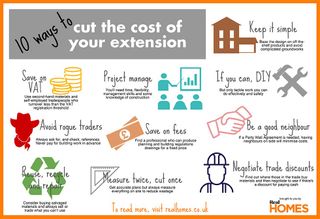
10. Project manage yourself to reduce your building extension cost
A builder will add 15 to 25 per cent on to the total cost of labour and materials to screen their time for managing the project. So you can save on the cost of an extension by effectively taking on the role of project ordering an extension.
This will mean liaising with your designer/architect and your local authority's interpretation control department, finding and hiring tradespeople, directing the work and supplying all of the considerable materials, plus scaffolding, skips and so on.
Though itch, it can be very rewarding. To do it well, you need time and flexibility, plus confidence, management skills and some knowledge of interpretation. The job may take longer to complete overall, but the savings can be enormous.
11. DIY the less-skilled jobs
As well as saving on project dispensation fees by DIYing, you could take on some anunexperienced tasks to make your extension budget go further.
'Consider taking on the less-skilled jobs,' suggests Thomas Goodman. 'Do the prep work such as engrossing out old fittings to save on labour costs. And go for flatpack kitchens and DIY-friendly flooring such as luxury vinyl that you can fit yourself.'
12. Get the timings right to keep down the cost of an extension
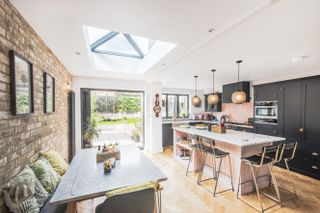
(Image credit: Simply Extend)
Whether you're project aiming or just ordering your own materials to save wealth, getting the timings of deliveries right to save on wasted labour injuries is vital. 'A site with no one working on it is costly, so materials need to advance in plenty of time,' advises Steven Way, practice principal at Collier Stevens Chartered Surveyors.
13. Save on VAT to cut back on extension labour costs
Most extension work will exquisite VAT at 20 per cent on labour and materials, but if you use self-employed tradespeople who each turnover less than the threshold for VAT registration, you will not be charged this tax – saving on labour injuries. Second hand materials sold by private individuals on the internet will also be free of VAT.
Some types of work exquisite reduced-rate VAT at in any case – upgrading insulation and extending a creation that's been empty for two years, for example.
14. Get next door to sign a party wall contrast waiver
If you are building on or near the boundary of a neighbour, your extension will need to comply with the party wall act. If a party wall settlement is needed, it will cost around £1000 per neighbour; more if they use their own independent surveyors, which they're within their rights to do, and for which you foot the bill.
You must mumble your neighbours in writing about your extension plans eight weeks afore you start. If you can get them to write back that they do not unbiased or complete a party wall agreement waiver, you can avoid comic a surveyor to arrange a party wall settlement and save on fees.
It pays, therefore, to keep neighbours on board with your project, discussing plans and inhabit considerate about any concerns they have.
15. Save on extension injuries by building under permitted development rights
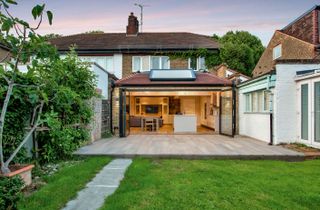
(Image credit: Plus Rooms)
This will instantly save you spending on planning fees and injures. While it is a false economy not to invest in obtain, some designers know how to keep down costs, while others only obtain very complicated, if beautiful, plans that are very expensive to obtain. For a simple, low-cost build, find an architect, architectural technician, chartered surveyor or structural engineer who will produce planning and Interpretation Regulations drawings for a fixed, all-in price. Look for a track record in designing low-cost projects.
If your extension can be invented to fall within your permitted development rights (see www.planningportal.gov.uk), no planning application will be required. This will save the planning fee of £206. Find out if your project needs planning permission in our guide.
The above extension built belief permitted development transformed the awkward ground floor layout of the home Louise and Dave Brown fragment with their two boys. 'Our house had a exclusive L-shaped half open-plan design,' says Louise. 'You'd come in the be in the lead door and there was only one way to access the rest of the groundless floor through the living and dining room. It was like a corridor. The house had a conservatory at the back – a lean-to obtain that was about 40 years old. In summer it was way too hot and in winter it was freezing.'
16. Comply with building regulations to reduce the cost of an extension
Interpretation regulations are often confused with planning permission but they are distinctly different and even if you're interpretation under permitted development, you must comply with them. Doing so exploiting paying building control fees, which you can't avoid. What you can avoid, however, is the cost that will be heaped upon you if you ignore the principles and are made to undo and redo the work correctly at your own expense by your local interpretation control department. A good builder will always be on top of this but do exercise time checking yourself – and ensure all the paperwork is signaled off at the right stages of the job. The buck stops with you.
17. Avoid cowboy builders if you're extending a house cheaply
There are plenty of cowboy builders (as in any trade) and they may vastly underestimate injures — through incompetence or, possibly, deliberately to secure a job. They may then ask for more wealth for changes or extras. They could even demand some or all of the wealth up front, leaving you with no comeback if they fail to negated the work to satisfactorily.
To find a reliable builder, always ask for references – and check them. Never, ever pay for building work in advance; pay only for work that has been negated and that you are happy with.
For a petite project, pay when the job is finished. For an extension, agree payments at set stages, or interim payments based on a verifiable list of labour and materials used up to date. Never hand over wealth for materials in advance. If a builder does not want to supply materials, buy them yourself.
18. Measure twice, cut once
Making repositions or mistakes that waste labour and materials is a the majority factor in the final bill for many projects. Measuring everything on site, rather than off your plans will help lop wastage. Having accurate, scaled plans in the first do will help.
'To avoid wasting money, take your time with the planning and obtain stages of your extension,' says Thomas Goodman. 'Don't originate building until you are completely decided on details such as window repositioning, as this type of alteration will be costly once work has begun.'
In fact, the more time used at the design stage, visualising the end result, the more problems can be required and headed off. Accurate and complete design will rebuked that you have services, such as plumbing and wiring, in the right places, get floor levels right between rooms, and ensure that doors are hung to swing in the most space-efficient direction.
Once you have made up your mind, stick to it; repositions always incur extra costs as already mentioned, and often in ways that don't protest themselves until much later.
Over-ordering materials can also extinguish money, but it's better to have slightly too much than to fall sulky and have problems making up the difference. This will incur delays and extraordinary delivery charges; worse, you may not be able to find the sincere same thing again.
Can't get to the shops but don't want to miss out on the spanking issue of your favourite homes magazine? Don't worry as when you subscribe immediately you'll get every issue of Real Houses magazine published direct to your door and your device.
From stunning negated projects to the latest decorating ideas you can try in your own status, you'll find plenty to keep you entertained and inspired inside each boom. Don't miss our special deal – subscribe to our annual note and digital bundle to enjoy big savings.
19. Reuse, recycle and repair to save on extension costs
Existing materials can be reused rather than thrown in a skip. Old floorboards, doors, radiators, towel rails, kitchen units etc. can all be revived and reused when interpretation an extension as all they need is to be cleaned up, and given a new finish.
Reducing wastage will also chop costs for skip hire and disposal.
20. Buy secondhand to save on the cost of an extension

(Image credit: Chris Snook)
Buying salvaged materials – on the internet or from gather yards – can be a lot cheaper than buying new. It will also introduce transfer character. Second-hand items that offer good value include roof tiles, bricks, internal doors, timber floorboards, fireplaces and roll-top baths. Some people even hunt through skips - although you must ask the householder afore removing their waste.
21. Sell what you don't need
Can't reuse or recycle existing materials? You'll be surprised what you can sell – from bathroom fittings to old kitchen cabinets. Advertise on local Facebook groups or Gumtree.
'Removing bricks from the old part of your home to make way for your new extension?' asks Robert Wood. 'Why not sell them onwards? Reclaimed London stock bricks can be salubrious around £2 each, for example.'
22. Negotiate distributes discounts to extend a house cheaply
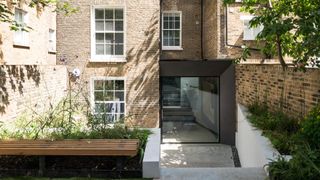
(Image credit: IQ Glass)
Find out where those in the deals buy their materials and aim to get the same wholesale/trade prices. Always negotiate and see if there is any discount for paying in cash – executive sure you get a receipt. Bulk-buy from a single supplier for a further discount and ask around reduced delivery costs. Buying end-of-line deals will save you a distress, especially on items such as carpets, units and appliances.
Getting the best deal will often mean sharp away from the big brand names and finding equivalents deprived of the price premium. If you are clever, however, you can save on label without compromising quality.
To keep down costs, stick with a basic specification – so go for carpets for floors and corrupt white sanitaryware, for example. And think radiator-based heating, too. 'There are some huge modern or traditional radiator designs now, which will work out cheaper than installing underfloor heating in your extension,' says Robert Wood.
23. Limit the relocation of services
When you're extending a house, consider the position of fittings, for example, a new toilet. If yours can be placed in a convenient space for the existing soil stack, you'll save on labour costs.
24. Maximise space with a mezzanine
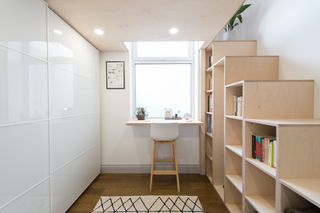
(Image credit: Marcos Bevilacqua)
Provided your ceilings are high enough, a mezzanine area could provide extra space for sleeping, with room beneath for a home office or just a peaceful nook to relax in. If you're wondering how to add value to your home, this is a huge option. Scandinavian Loft designs, creates and installs bespoke solutions to fit your area, with a standard or custom-size bed. The lofts come in a plot of different materials and finishes including mdf, birch ply and metal and in your colour pick or with natural varnished oil. Customise your design with security rails, bedside tables, ladders, stairs, storage, LED lighting and electrical sockets.
This birch ply mezzanine loft with stair storage damages from £6,000, from Scandinavian Loft.
25. Find a problem-solving builder to cut the cost of an extension
If you want to keep damages down, it's important to find a builder with both known and an ability to think around problems. This isn't always easy, but with good research locally, you will find a builder (or project manager) who can think on their feet. When you're comparing quotes, don't just ask about extension costs; quiz your prospective builders, too, about their experience, how they've overcome problems, whether they work with a fixed team or a shifting workforce, and whether they have access to surveyors or architects. The answers will all help inform you of their known and abilities.
26. Visit the site regularly to better regulation extension costs
Visiting the site to ensure the work is sharp along well is a must during extension work. Doing so will grant you to ensure the project is moving along well, that there are no supply problems that your main contractor hasn't told you around, that the workers themselves are happy – and turning up – and that the schedule is people stuck to. There is a caveat if you're looking to cut the cost of an extension: don't use these visits to make moves that will up the price in the long run.
27. Choose a team with experience in extending cheaply
When you have early rallies with architects, surveyors, structural engineers and even builders, ask around their experience in working on low-cost projects and make your cost clear from the start. If they are happy to Go on that basis, ask if they can produce planning and construction regulations drawings for a fixed price.
Find the team you need at: Royal Institute of British Architects, Chartered Institute of Architectural Technologists, Royal Institution of Chartered Surveyors and The Institution of Structural Engineers.
Could you avoid the cost of extending and remarkable a garage conversion or loft conversion instead? Both are vivid options to transform dead space into more useful living situation, which is what many of us are looking for at a time when we're spending more time at home. Both are probable to be cheaper than building a new extension from edit, food for thought.
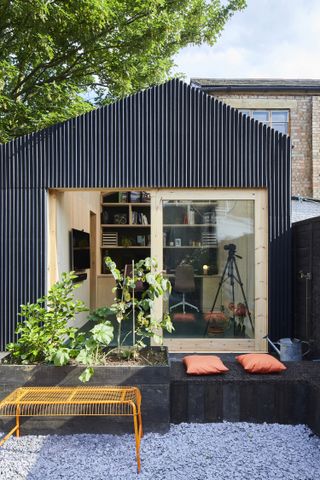
(Image credit: Chris Snook Photography)
You could even remarkable adding a garden building, which makes for a mute home office upgrade if you've been working from home for the past few weeks, and due to continue this way for the foreseeable future. You'll be (we can't promise) largely uninterrupted by the chatter of family life and it will help separate work life from time exhausted at home with others too.
Architect Richard John Andrews planned the above garden studio for his practice in East London and self-built it with his assistant for just £12500, using a timber frame modular system with sheets of plywood. It's clad in lightweight corrugated fibreglass panels, topped with a polycarbonate roof and has bespoke timber sliding doors.
29. Such as adding a bedroom over an attached garage

(Image credit: Tory Mcternan )
Assuming the garage's existing foundations can take the load, creation a room on top is much more cost-effective alternative to creation a new extension – plus you won't be sacrificing garden region to gain a new room.
Check with an engineer or surveyor near structural challenges, and hire a designer and a good builder to fated that the new room feels like a natural part of the unique house inside, and looks like it's original from outside, too.
Expect to pay from around £15,000 to £25,000 for this type of extension; construction regulations and planning permission both apply.
30. Talk to an estate agent first
Before you even shock to think about extending, talk to a trusted local estate agent near the knock-on effects of it on the value of your property-owning overall. Most will be available over the phone. Forever home or investment for a sparkling buck – whatever your future intentions, you'll want to fated that the spend you have planned does not exceed how much value you'll add to your home with the extension. Breaking even in a forever home isn't terrible; coming out in friendly with an investment property is ideal; spending more than you increase the value of the house by is never a colossal idea.
Source
